MARIANI’SVirtual Gourmet
November
13, 2011
NEWSLETTER
THIS WEEK: What Your Favorite Restaurant Knows About You.
The
5th
Annual Palm Beach Food & Wine Festival
will take place this year from Dec. 9-13,
with a star-studded, epicurean extravaganza
hosted on the resort island playground of Palm
Beach. Join James Beard Award-winning chefs,
Food Network personalities, authors,
winemakers, mixologists and a plethora of
local talent in an unforgettable series of
dinners and parties that will saturate your
senses in the most anticipated culinary event
of the season. Chefs include Michelle
Bernstein, Daniel Boulud, David Burke, Clay
Conley, Scott Conant, Dean Max, Michael
Schwartz, and many more. John
Mariani is proud to be Honorary Chairman. For info click here.
❖❖❖
THIS WEEK
DAY TRIPPER: GHENT, BELGIUM
by John Mariani
NEW YORK CORNER: EL PARADOR
by John Mariani
WINE: THE LURTON DYNASTY
by Mort Hochstein
Big cities demand a traveler's commitment to stay put for several days, or, as has been said of great cities like New York, Rome, London and Paris, if you spend a week there you'll know the city well; if you spend a lifetime, you'll realize how much you don't know. Smaller cities, however, can be visited with pleasure for a day or two, to take in the principal sights and determine if you want to return for a longer stay. In fact, I find such visits extremely enjoyable and, more often than not, make me hungry for more. This article is another in a continuing, occasional series I call "Day Trippers," intended to give the reader a quick, broad overview of a city where I was delighted for just a day or two. --J.M.
by John Mariani
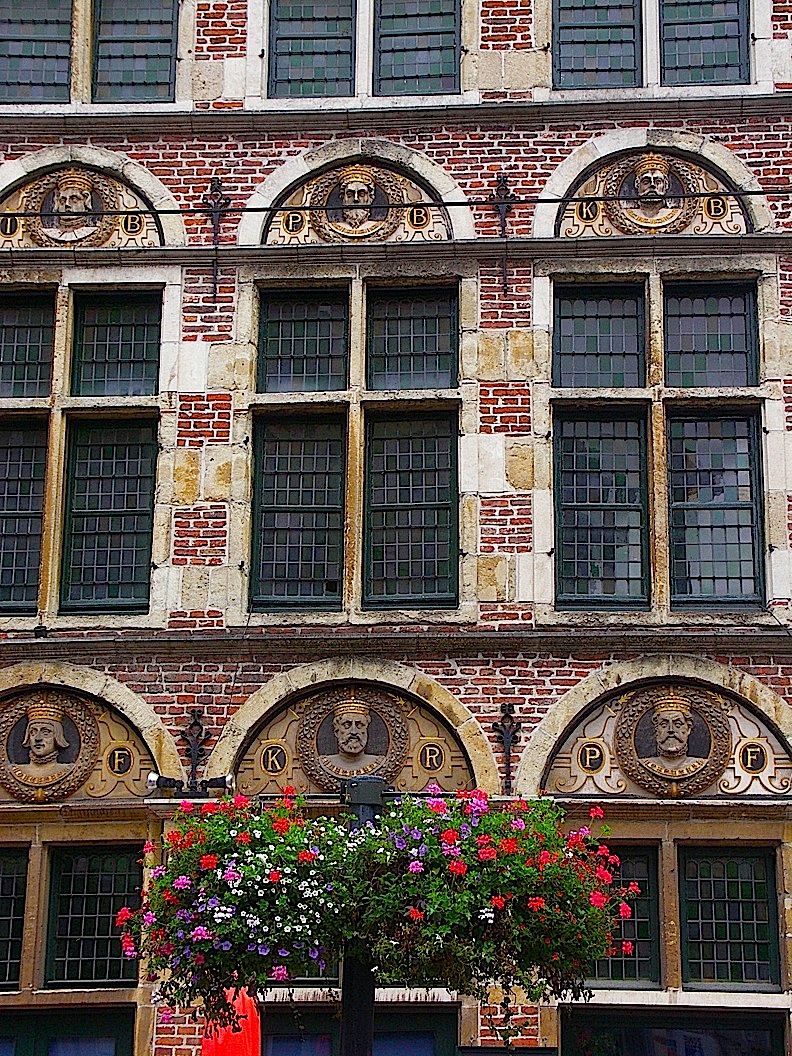
The citizens of Ghent want to make sure a visitor is duly impressed upon arrival, and after exiting a train from another point in Europe and moving up an escalator to the entrance hall of the station (right), you will be very impressed indeed.
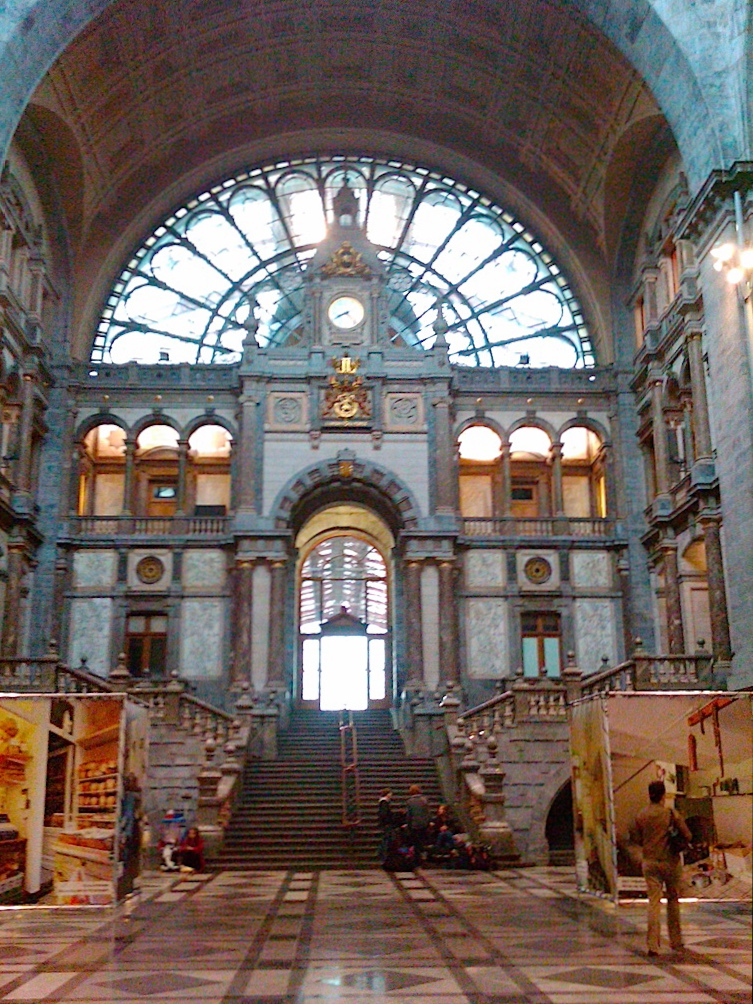
Train stations are the first thing many people see when entering a city and help to set the scene for the spirit of a city. And there are few more beautiful train stations in Europe than Ghent's, having been designed in a cruciform shape by Louis Cloquet and built just a year before the 1913 World Exhibition to show this old city had acquired a wholly modern face.
I have no idea why the British added an "h" to the Celtic-Latin name Gent, but there it is stuck, derived from a Latin word that meant a "place between two rivers." In any case, everyone, but everyone, speaks English perfectly. With a half million inhabitants, Ghent is Belgium's second largest city, but it has a small city feeling to it, owing to its inner historic core where rivers and streets seem to make up their own minds as to where they will go, and the natives are fine with the idea of meandering throughout the broad plazas and narrow streets, the alleys and cul de sacs where at one time or another a great merchant or prince may have lived. Since many streets are closed to motor traffic, Ghent is as amiable a walking city as any in Europe. And pleasingly quiet.
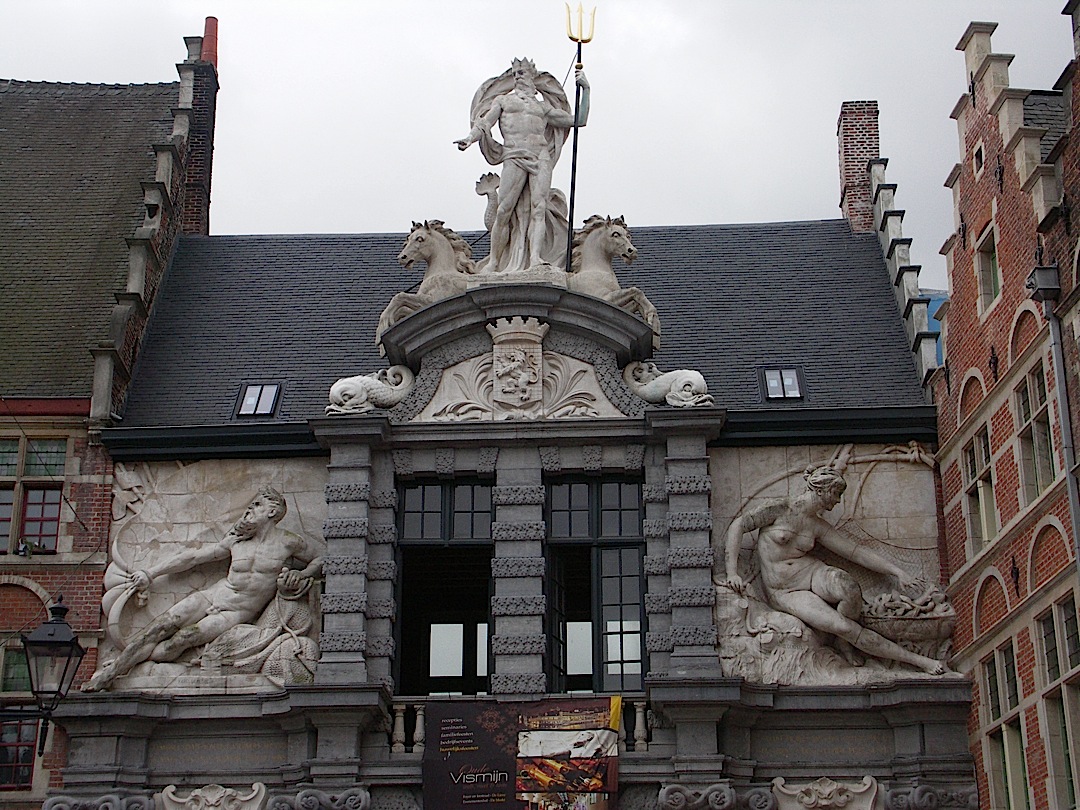 Its buildings
have an enormous variety of architecture, for while
the twilight picture below shows massed historic
buildings, some dating to the 12th Century,
none is of the same style, because with each passing
era the Ghentians believed strongly they should not
hang onto the past and so encouraged architects to
design buildings in the newest style of the day;
thus, you find late Gothic, Renaissance and Baroque
structures bunched along the river and throughout
the city, most richly decorated in ways you do not
associate with the stoic-looking town fathers and
guild members in the paintings of those days. To
prove the point, there is a new, very modern Town
Hall under construction whose steel lines echo the
old roof lines but are in every other way completely
of the moment. Along the rivers are also great
old brick structures that were once warehouses,
butcheries, and markets, now converted into
everything from fish restaurants and student
cafeterias to retail stores.
Its buildings
have an enormous variety of architecture, for while
the twilight picture below shows massed historic
buildings, some dating to the 12th Century,
none is of the same style, because with each passing
era the Ghentians believed strongly they should not
hang onto the past and so encouraged architects to
design buildings in the newest style of the day;
thus, you find late Gothic, Renaissance and Baroque
structures bunched along the river and throughout
the city, most richly decorated in ways you do not
associate with the stoic-looking town fathers and
guild members in the paintings of those days. To
prove the point, there is a new, very modern Town
Hall under construction whose steel lines echo the
old roof lines but are in every other way completely
of the moment. Along the rivers are also great
old brick structures that were once warehouses,
butcheries, and markets, now converted into
everything from fish restaurants and student
cafeterias to retail stores. Ghent's main street and one of the oldest is Veldstraat, from which narrow alleys depart, once the site of the Corn Market and a hotel center, now the principal shopping area of the city. Sadly, the street has lost many of its old buildings and shops, but the still impressive Hotel Schamp is a baroque structure from the 18th century, and several historic mansions still lining Veldstraat.
We stayed at the fine 46-room boutique Hotel De Flandre (right), very quietly and centrally located, which
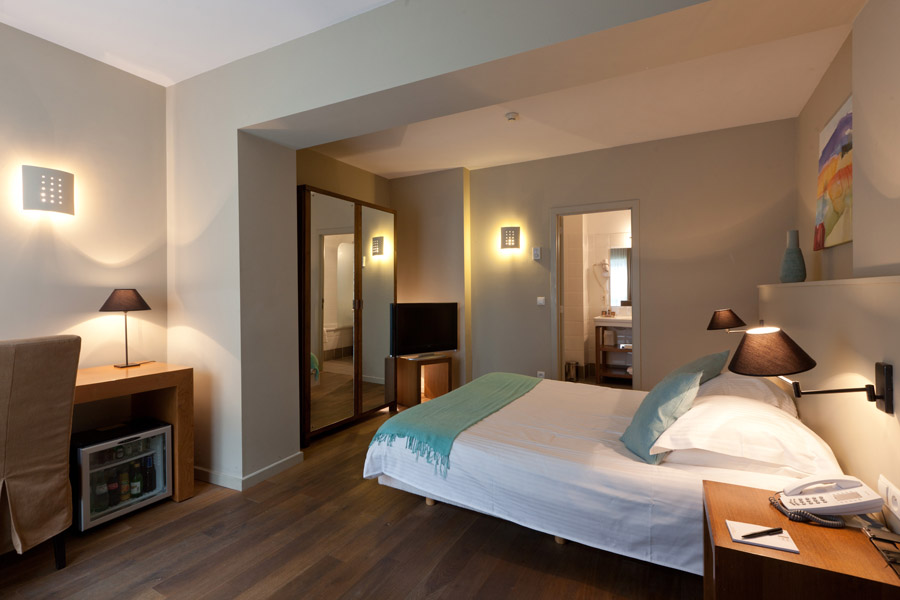 has a bracing, lavish buffet (included
in the room price), while our friends stayed two
blocks away at the newly renovated Standton
Grand Hotel Reylof, with 158 rooms, once an
18th-century townhouse. The ultra-modern,
always booked Ghent
Marriott, with its high glass dome, seems
oddly situated down a narrow street, including its
main entrance, but this was the only way Bill
Marriott could convince the city his hotel would not
intrude on the glorious historic riverscape, where
the hotel's smaller, unobtrusive entrance is
located.
has a bracing, lavish buffet (included
in the room price), while our friends stayed two
blocks away at the newly renovated Standton
Grand Hotel Reylof, with 158 rooms, once an
18th-century townhouse. The ultra-modern,
always booked Ghent
Marriott, with its high glass dome, seems
oddly situated down a narrow street, including its
main entrance, but this was the only way Bill
Marriott could convince the city his hotel would not
intrude on the glorious historic riverscape, where
the hotel's smaller, unobtrusive entrance is
located. Ghent's gastronomy is richly northern European but highly influenced by French cookery and readily accessible to ethnic ideas, so that there is every type of restaurant here, from pizza to sushi, and you'll find Turkish restaurants have a stronghold along Sleepstraat. Thursdays are called Donderdag Veggiedag, when public canteens and schools promote their vegetarian dishes, which is a rather odd idea in a country whose good health is not in question. Where the city should put its efforts is to stamp out smoking, now broadly indulged at outdoor tables at restaurants, meaning that anyone who is not a smoker is likely to be engulfed in cigarette smoke for the sin of wanting to dine al fresco.
After touring much of the historic district, we had lunch at a very popular brasserie off the grand plaza, across from the Ghent Opera, called, appropriately, Café Theatre, both dating to 1840, with a hiatus of nine year's closing, re-opened in 1998. The restaurant is a cavernous and friendly, a a youthful place, with notes on the menu that the staff, whose photos are on the menu, is dressed by Terre Bleue, a Belgian sportswear company, and they sell their own CDs and photo books. The menu notes, "Slow service on request," meaning this is a place to take your time, not to rush through your beer or wine--unless you're on your way to the opera--and to enjoy the pleasures of Belgian-French food and drink. At lunch it was filled with people off from work, business people, tourists, and one elderly well-dressed Ghentian gentleman at the corner table next to ours who sat with
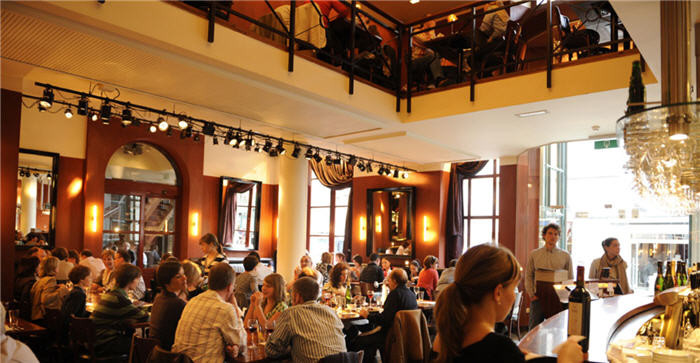 his newspaper
and spent the afternoon quietly feasting on a
three-course meal, all by himself, looking wholly
content with his own company and probably well
practiced in dining at Café Theatre several
times a week.
his newspaper
and spent the afternoon quietly feasting on a
three-course meal, all by himself, looking wholly
content with his own company and probably well
practiced in dining at Café Theatre several
times a week. Our party of four began with a good portion of mi-cuit duck foie gras with fig chutney and toasted brioche; a specialty here is the beef tartare with Belgian fried potatoes (which are sold as a snack all over the city, with toppings from mayonnaise to vinegar), again a hefty portion. Shrimp croquettes were tidy little morsels with lemon and fried parsley, while a sweet tomato came stuffed with tiny peeled grey shrimp. The dish of the day was a plate of those ultra-tender morsels of chicken imbedded in the crook of the thigh, here lightly sautéed crisp and hot.
For our main courses we had a juicy roasted monkfish with smoky bacon, mashed green lentils and fried potatoes; sautéed sole in a classic buttery meunière style, with steamed potatoes; and an entrecôte of Scottish beef with a rich Béarnaise, grilled potatoes and seasonal vegetables, ending off the meal with a selection of housemade sorbets.
Prices may seem high to Americans bemoaning the weak dollar, but they are moderate for Belgium, with starters ranging from €13.50 to €18 and main courses €18.50 to €26.
That afternoon we also had a chance to visit the Gruut Brewery in the center of the city, about which I wrote last week here.
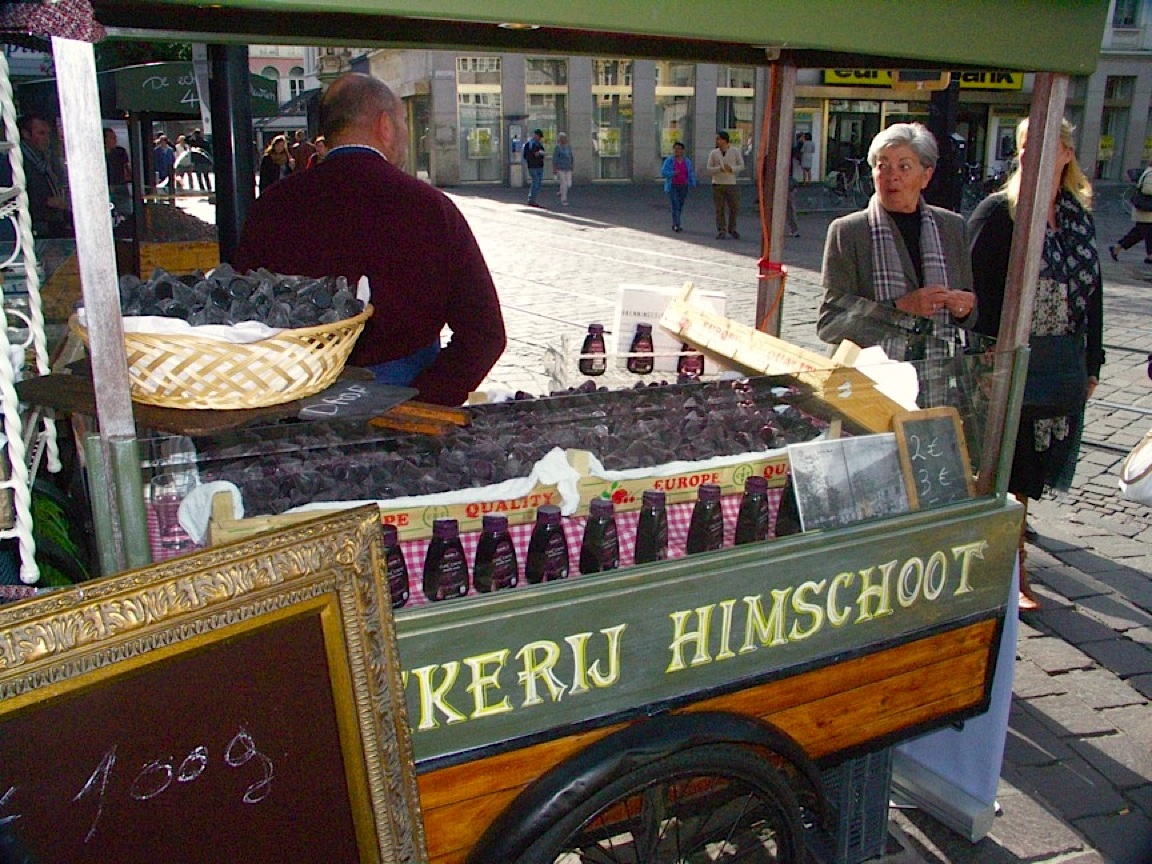 And, after a good walk, we
noshed a bit more--a yeasty Belgian waffle split
among the four of us, a visit to a chocolate shop or
two, and something new to us--cuberdon candy,
made since the 19th century by only a very few
candymakers (right).
It is a little purple cone of sugar containing
raspberry syrup, which oozes out when you bite into
it.
And, after a good walk, we
noshed a bit more--a yeasty Belgian waffle split
among the four of us, a visit to a chocolate shop or
two, and something new to us--cuberdon candy,
made since the 19th century by only a very few
candymakers (right).
It is a little purple cone of sugar containing
raspberry syrup, which oozes out when you bite into
it. That evening we enjoyed an aperitif of elderberry liqueur called roomer, then went to an even bigger place--600 square meters--and a magnet for everyone who lives or visits Ghent--a multi-tiered restaurant named Pakhuis (warehouse), this year celebrating its 20th anniversary. You come upon the place suddenly after passing down an alleyway, and you look up and see people everywhere: downstairs at the bar, in a room reached by ramp, up the stairs to the mezzanine and balcony (below). In the Chef's Corner at the bar you can feast on iced shellfish.
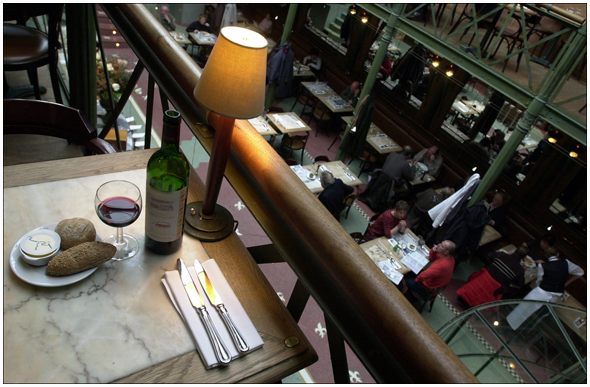 Chef Koen Lefever is justly proud of
his commitment to the very finest ingredients--many,
including the famous blue-footed Bresse chickens,
raised at the restaurant's own farm, and to
sustainability; they even have their own wine
label; Pakhuis also supports many charitable
organizations through special dinners throughout the
year. You can certainly taste the truth
of it all in the food, and a good way to go about it
is with the Market Menu at about €43, currently
featuring smoked eel and fried mussel salad; various
oysters; baked fillet of mullet and mussels with
tagliatelle; roasted fillet of guinea fowl (its own)
with chicory and celery root; and apple puff pastry
with ice cream. There are also both cheaper and more
extensive fixed price menus. À la carte, we
enjoyed a pan-roasted lobster with vegetables, and
the Bresse chicken had wonderful flavor and crisp
skin.
Chef Koen Lefever is justly proud of
his commitment to the very finest ingredients--many,
including the famous blue-footed Bresse chickens,
raised at the restaurant's own farm, and to
sustainability; they even have their own wine
label; Pakhuis also supports many charitable
organizations through special dinners throughout the
year. You can certainly taste the truth
of it all in the food, and a good way to go about it
is with the Market Menu at about €43, currently
featuring smoked eel and fried mussel salad; various
oysters; baked fillet of mullet and mussels with
tagliatelle; roasted fillet of guinea fowl (its own)
with chicory and celery root; and apple puff pastry
with ice cream. There are also both cheaper and more
extensive fixed price menus. À la carte, we
enjoyed a pan-roasted lobster with vegetables, and
the Bresse chicken had wonderful flavor and crisp
skin. Afterwards we joined those throngs of people who take the two-hour Light Plan walk, when the historic buildings of Ghent are brilliantly illuminated like a movie set, a leisurely stroll under starlight and clouds, moonlight and shadows, giving the city the calm beauty of a medieval romance. We didn't last the whole two hours, though, filled as we were with a good dinner and fine wine, but we took in enough to know that returning to Ghent was now much higher on our wish list than we could have imagined a day before.

NEW YORK CORNER
by
John Mariani
El
Parador Cafe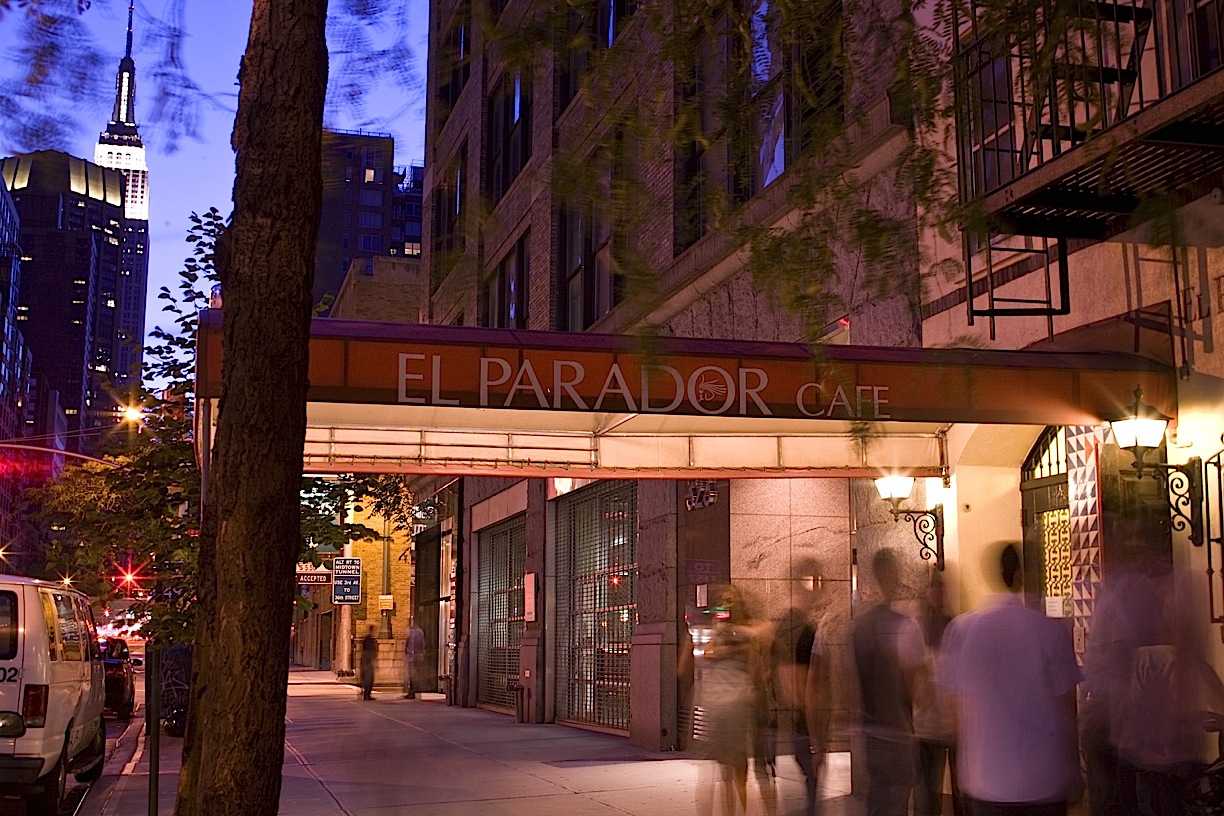
325 East 34th Street (near First Avenue)
212-679-6812
www.elparadorcafe.com
El
Parador Café in Murray Hill is not, as claimed, NYC's oldest Mexican
restaurant (defunct places named Xochitl on West
46th Street and Mexican Gardens on Waverly Place
dated back at least to the 1940s), but after six
decades in business it can claim to be the most
longlived, having been opened in 1959, and in my
opinion, one of the very best in the city.
Under two owners,
first Carlos Jacott and since 1990 Manuel
Alejandro, who handed things over to his son Alex
in 1994, El Parador has never gone the Tex-Mex way
or taken a middle ground as a pseudo-Spanish
restaurant. So if you can pick out the
regions of Mexico the menu is built on, you may
simply call it El Parador Mexican food and be very
happy that it has not changed what it does best.
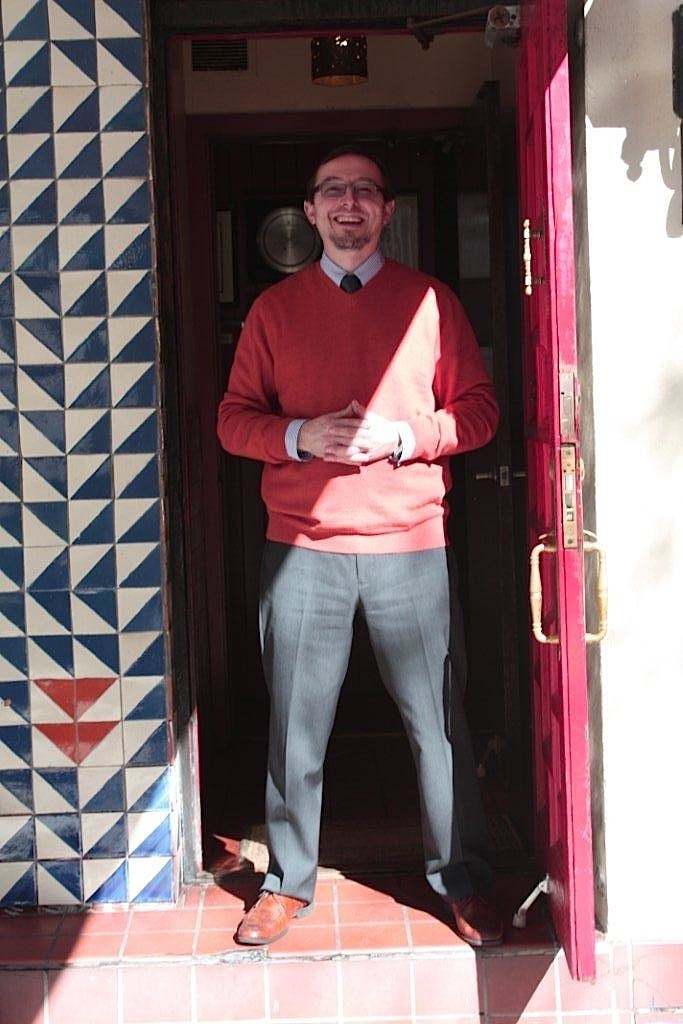 Owner Alex Alejandro (left) is a
marvelous host, a handsome, well-dressed fellow with a
small goatee and a big smile. If he seems to know
everyone who comes through the unassuming doorway, the
chances are good he does, since El Parador gets an
extremely faithful local crowd. With 160 seats
to fill, including the subterranean party room called
La Cueva, Mr. Alejandro, Chef Boni Junior, and
his waiters have fine tuned everything so that the
tempo of a meal, which inevitably begins with a round
of well-made and proportioned margaritas from an array
of tequilas, is clearly set for people who are very
hungry once they sit down, which seems always to be
the case when people decide to go out for Mexican
food. So thank heavens that El Parador serves those
irresistible tortilla chips (with two salsas) that
restaurants in Mexico itself foolishly eschew.
Owner Alex Alejandro (left) is a
marvelous host, a handsome, well-dressed fellow with a
small goatee and a big smile. If he seems to know
everyone who comes through the unassuming doorway, the
chances are good he does, since El Parador gets an
extremely faithful local crowd. With 160 seats
to fill, including the subterranean party room called
La Cueva, Mr. Alejandro, Chef Boni Junior, and
his waiters have fine tuned everything so that the
tempo of a meal, which inevitably begins with a round
of well-made and proportioned margaritas from an array
of tequilas, is clearly set for people who are very
hungry once they sit down, which seems always to be
the case when people decide to go out for Mexican
food. So thank heavens that El Parador serves those
irresistible tortilla chips (with two salsas) that
restaurants in Mexico itself foolishly eschew.
The place can get very loud, though
even with a nearby table of ten young women well into
Margaritaville, we could hold a conversation at our
table.
The menu is large, so if it's your
first time, let Mr. Alejandro make suggestions.
Somehow he seems to be at six tables at once but he
never seems rushed, nor will he rush his guests.
Platter after platter came to our table, including aguachile, a shrimp ceviche done with
lime juice, cucumber and jalapeño; a delicious
three-mushroom quesadilla, with Oaxacan
cheese, creminis, shiitakes and portobellos; and
really hot pickled jalapeños stuffed with
peanut butter, which required several gulps of Mexican
beer to cool down. The only appetizer I thought was a
little bland was El Parador's guacamole, but maybe you
can ask for a little more spice and seasoning.
Mexico's form of meatballs--albondigas, made
with beef and pork--were excellent, full of flavor,
and a mulato mole
negro with Maduro plantains hit the spot,
actually serving to rev up an appetite we thought
might have flagged by then. But no, we dig into
the succulent pork tenderloin and tomatillo tamal, and the
lobster sauté in an enchilada  with a tomato and scallion pumpkin seed
mole, whose ingredients did nothing to compromise the
flavor of the lobster meat.
with a tomato and scallion pumpkin seed
mole, whose ingredients did nothing to compromise the
flavor of the lobster meat.
Roast duck enchilada with a poblano
and onion sofrito
and a peanut and tomato mole was outstanding--the best dish
among many terrific ones, and we also enjoyed braised
chicken breast in mole
poblano, with dried chilies, chocolate and fruits. The
barbacoa de puerco--baby
back ribs steamed in banana leaves with an achiote and cumin
rub and a tequila BBQ salsa put us over the top, but
not before we somehow managed to sample El Parador's
rich pecan pie and tres
leches cake. Somehow the charms of
Mexican fried ice cream continue to escape me.
You can readily tell that the menu
here is not just a repro of most every other Mexican
place in town, where combo platters and ten variations
on the enchilada rule. Having just returned last
week from Mexico City, I found El Parador's food as
delicious as any I had at the traditional restaurantes
there. With the closing of NYC's Zarela's and
the expansion of Rosa Mexicano into a chain from here
to Minneapolis, El Parador has few competitors at its
level in NYC. And with time on its side, El Parador
has shown that consistency coupled with a commitment
to gracious hospitality trumps them all.
Open for lunch and
dinner daily. Closed Sundays in
August and major holidays. Appetizers $6-$16, entrees
$11-$29.
❖❖❖

MAN ABOUT TOWN
by Christopher Mariani
His column will appear next week.
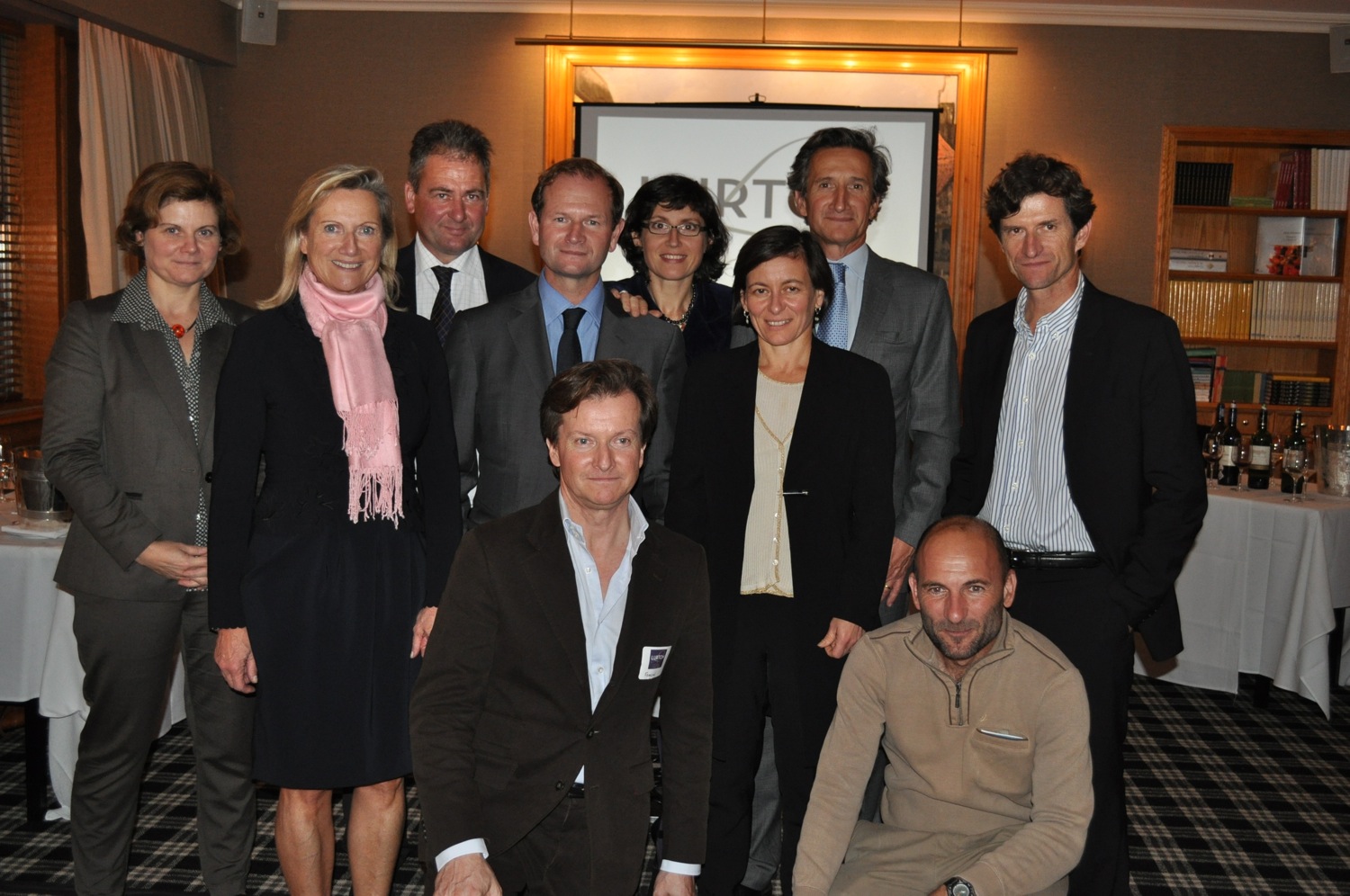
Mondavi and Gallo in the United
States, Rothschild
in France, Antinori in Italy. These are the names that
come to mind when I think about great wine families.
But the largest and least heralded of them all
are the Lurtons of Bordeaux, whose ten family members
quietly own or administer some 30 properties in France and
throughout the world, the best known being
Château d’Yquem , Cheval Blanc and
Brane-Cantenac.
The Lurton dynasty originated in the late
1800's when the founding father, Jean-François
Recapet added on to
the family liqueur business with a campaign
of vineyard acquisitions
his descendants continued into the current century.
The Lurtons began by acquiring Brane-Cantenac, a second growth
Bordeaux, and a share in its prestigious neighbor,
Château Margaux, which they later traded for
other property. La
Louvière as well as other less well
known acquisitions, primarily in Graves and Entre-Deux
Mers, came
into the
Lurton fold over the years.
As
in any family, there have been stresses and strains
among the siblings, but two years ago, they consolidated
their activities under
the banner of
Lurton du Vin. The ten principal members, whose
busy schedules
prevent them from gathering as frequently
as they might like,
convened at
Restaurant Benoit in NYC recently to trumpet
their unity,
while showing
wines from Lurton
ventures in Australia, Spain, Argentina, Chile, Portugal, South Africa and Spain, as
well as France.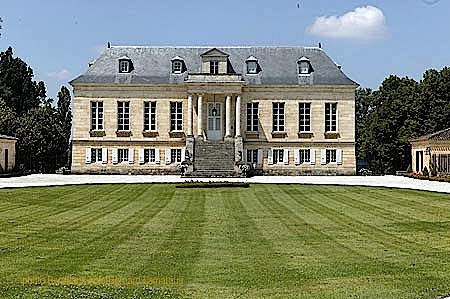
I mentioned
La Louvière (right)
because it is one of my favorite white wines, one that
comes with a happy
memory. I first encountered La Louvière
many years ago while filming the harvest in Bordeaux
with the late food and wine authority, Roy Andries
DeGroot. We
had been
invited to Château
Haut-Brion to meet and
have lunch with
top producers
of the
Graves region.
While
DeGroot
was able to parlez
Francais with those notables, I barely
understood menu
French and elected to join my camera crew under
a shady tree. It
was a good decision. Waiters from that great Haut
Brion château
plied us with great wines and oysters from bottomless
sacks. I
couldn’t have been happier and that was where I
developed my liking for
La Louvière.
Since
that long-ago time, the
family leadership has shifted to a younger generation, Some
members have become flying winemakers, working in
South Africa, Australia,
Chile and Argentina as well as in neighboring Spain
and Portugal.. All have contributed to expanding the
empire, while assuming executive roles in many of the
Bordeaux wine associations
and others have taken managerial positions at major domaines
owned by giant corporations.
La
Louvière white,
to my disappointment, was not included in the tasting,
but I was happy to
catch up with
two wonderful dessert wines from
Château Climens
(below), a
first growth
Barsac-Sauternes, owned by
Bereneice Lurton.
I tasted the top wine of the estate, Climens
2005 ($95) and its second wine, Cypres de Climens 2007
($50), which was fuller and better balanced than its
younger sibling, but I would have been happy to take
either of those sweeties home.
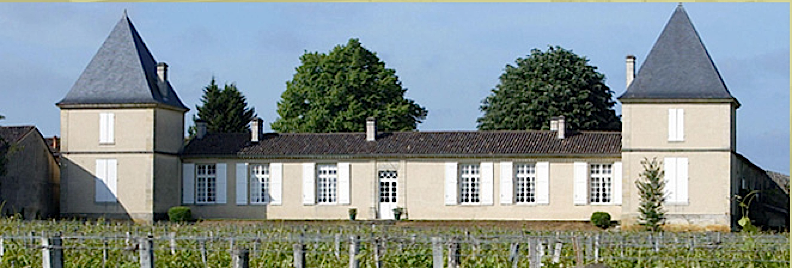 Another of my
favorites, Bonnet Blanc from the Lurton ‘s ancestral
home in Entre-Deux Mers , was another favorite
for me. It’s a blend of 50% sauvignon blanc, 40%
semillon and 10% muscadelle, wafting aromas of
grapefruit and acacia flowers, tangy and
lemony on
the palate, all at a very attractive list price
of $13 , probably less in many stores. In the same
price range, Bonnet fielded a
Bordeaux rosè and red . Andre
Lurton did bring us a 2006 La Louvière red from
Pessac-Léognan in the Graves region, a
classically dry
Graves, reserved
and well structured, with some gravelly fruit and soft
tannins, needing a few more years in bottle to show at
its best ($57).
Another of my
favorites, Bonnet Blanc from the Lurton ‘s ancestral
home in Entre-Deux Mers , was another favorite
for me. It’s a blend of 50% sauvignon blanc, 40%
semillon and 10% muscadelle, wafting aromas of
grapefruit and acacia flowers, tangy and
lemony on
the palate, all at a very attractive list price
of $13 , probably less in many stores. In the same
price range, Bonnet fielded a
Bordeaux rosè and red . Andre
Lurton did bring us a 2006 La Louvière red from
Pessac-Léognan in the Graves region, a
classically dry
Graves, reserved
and well structured, with some gravelly fruit and soft
tannins, needing a few more years in bottle to show at
its best ($57).
The
Lurton’s French
empire centers
on Entre-Deux Mers and on the Bordeaux peninsula,
Margaux and Pessac-Léognan. It includes several better
known Margaux estates such as Dauzac, Durfort Viviens
and Desmirail, and
several lesser ranked estates such as La Tour
de Bessan and Villegorge.
Despite their long history in the region and
the pedigree attached to their great estates, the
assembled Lurtons came across with little pretension,
showing none of the hauteur often evident in the great
families of Bordeaux.
As one member declared: “Notre travail
nous depasse, ” loosely translated as “Who we
are is less important than what we do.” Jacques
Lurton, spokesman for the group, put it this way. “We
are not typical Bordeaux aristocrats. We are simply a
hardworking bourgeois family.”
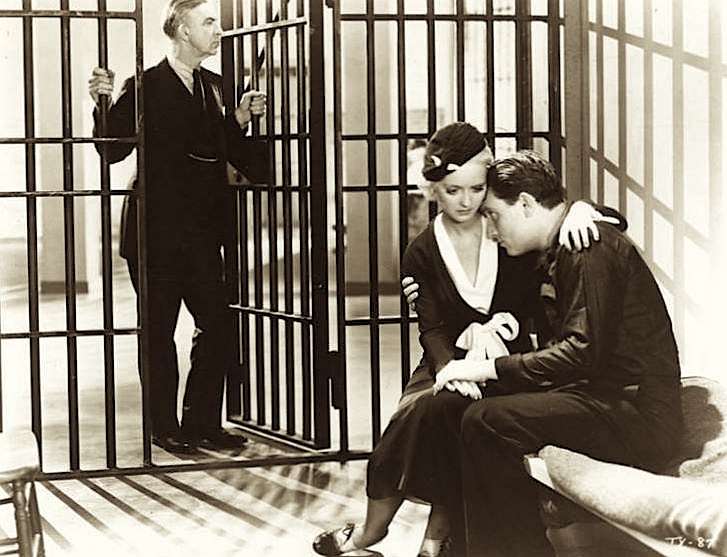
STALE BREAD AND COLD WATER!!!
A
former jailhouse inmate turned jailhouse cook, Brian
D. Price, has cooked last meals for 218 prisoners on
death row in Huntsville, TX, but after state
officials said they would no longer provide
condemned prisoners their last meal requests, Price
offered to prepare meals for free. The officials
said no thanks.
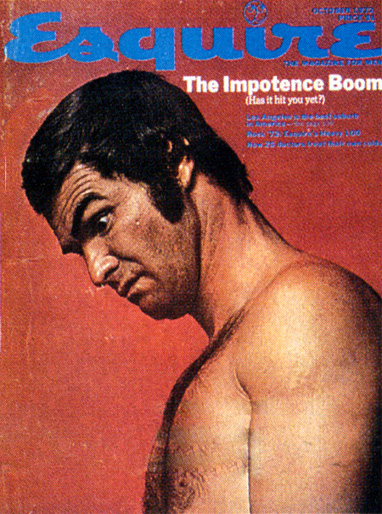 ODDEST FOOD MARKETING PITCH OF
2011 (SO FAR)
ODDEST FOOD MARKETING PITCH OF
2011 (SO FAR)
"I'm writing on behalf of the
American Pistachio Growers. Pistachios have been
shown to be pretty important when it comes to a
man’s sex life. Here’s a couple quick fun bullets:
·
Men
with erectile dysfunction saw improvements in
function and satisfaction after eating 3.5 ounces of
pistachios daily for 3 weeks
·
A
typical one-ounce service of pistachios contains 160
calories-making it easier to maybe lose love
handles.
·
In
ancient Persia, lovers used to meet under pistachio
trees and listen to the crackling of nuts in the
moonlight-and maybe more.
Could make an interesting sidebar
for Esquire."
--Ketchum Social Media.
❖❖❖
Any of John Mariani's
books below may be ordered from amazon.com.
 |
My latest book, written with Jim Heimann and Steven Heller, Menu Design in America, 1850-1985 (Taschen Books), has just appeared, with nearly 1,000 beautiful, historic, hilarious, sometimes shocking menus dating back to before the Civil War and going through the Gilded Age, the Jazz Age, the Depression, the nightclub era of the 1930s and 1940s, the Space Age era, and the age when menus were a form of advertising in innovative explosions of color and modern design. The book is a chronicle of changing tastes and mores and says as much about America as about its food and drink.
“Luxuriating vicariously in the pleasures of this book. . . you can’t help but become hungry. . .for the food of course, but also for something more: the bygone days of our country’s splendidly rich and complex past. Epicureans of both good food and artful design will do well to make it their cofee table’s main course.”—Chip Kidd, Wall Street Journal.
“[The menus] reflect the amazing craftsmanship that many restaurants applied to their bills of fare, and suggest that today’s restaurateurs could learn a lot from their predecessors.”—Rebecca Marx, The Village Voice. |
"Eating Italian will never be the same after reading John Mariani's entertaining and savory gastronomical history of the cuisine of Italy and how it won over appetites worldwide. . . . This book is such a tasteful narrative that it will literally make you hungry for Italian food and arouse your appetite for gastronomical history."--Don Oldenburg, USA Today. "Italian
restaurants--some good, some glitzy--far
outnumber their French rivals. Many of
these establishments are zestfully described
in How Italian Food Conquered the World, an
entertaining and fact-filled chronicle by
food-and-wine correspondent John F.
Mariani."--Aram Bakshian Jr., Wall Street
Journal.
"Equal parts
history, sociology, gastronomy, and just
plain fun, How Italian Food Conquered the
World tells the captivating and delicious
story of the (let's face it) everybody's
favorite cuisine with clarity, verve and
more than one surprise."--Colman Andrews,
editorial director of The Daily
Meal.com. "A fantastic and fascinating
read, covering everything from the influence
of Venice's spice trade to the impact of
Italian immigrants in America and the
evolution of alta cucina. This book will
serve as a terrific resource to anyone
interested in the real story of Italian
food."--Mary Ann Esposito, host of PBS-TV's
Ciao
Italia. "John Mariani has written the
definitive history of how Italians won their
way into our hearts, minds, and
stomachs. It's a story of pleasure over
pomp and taste over technique."--Danny Meyer,
owner of NYC restaurants Union Square Cafe,
Gotham Bar & Grill, The Modern, and
Maialino.
|
 |
 |
 |
 |
 |
 |
 |
 |
 Everett Potter's Travel Report:
Everett Potter's Travel Report: 
 Eating Las Vegas
is the new on-line site for Virtual Gourmet
contributor John A. Curtas., who since 1995
has been commenting on the Las Vegas food
scene and reviewing restaurants for Nevada
Public Radio. He is also the
restaurant critic for KLAS TV, Channel 8 in
Las Vegas, and his past reviews can be
accessed at KNPR.org.
Click on the logo below to go directly to
his site.
Eating Las Vegas
is the new on-line site for Virtual Gourmet
contributor John A. Curtas., who since 1995
has been commenting on the Las Vegas food
scene and reviewing restaurants for Nevada
Public Radio. He is also the
restaurant critic for KLAS TV, Channel 8 in
Las Vegas, and his past reviews can be
accessed at KNPR.org.
Click on the logo below to go directly to
his site.

Tennis Resorts Online: A Critical Guide to the World's Best Tennis Resorts and Tennis Camps, published by ROGER COX, who has spent more than two decades writing about tennis travel, including a 17-year stretch for Tennis magazine. He has also written for Arthur Frommer's Budget Travel, New York Magazine, Travel & Leisure, Esquire, Money, USTA Magazine, Men's Journal, and The Robb Report. He has authored two books-The World's Best Tennis Vacations (Stephen Greene Press/Viking Penguin, 1990) and The Best Places to Stay in the Rockies (Houghton Mifflin, 1992 & 1994), and the Melbourne (Australia) chapter to the Wall Street Journal Business Guide to Cities of the Pacific Rim (Fodor's Travel Guides, 1991).

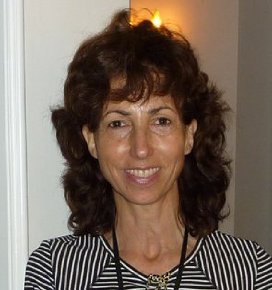
The Family Travel Forum - A
community for those who "Have Kids, Still Travel" and
want to make family vacations more fun, less work and
better value. FTF's travel and parenting features,
including reviews of tropical and ski resorts, reunion
destinations, attractions, holiday weekends, family
festivals, cruises, and all kinds of vacation ideas
should be the first port of call for family vacation
planners. http://www.familytravelforum.com/index.html
ALL YOU NEED BEFORE YOU GO
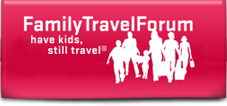

MARIANI'S VIRTUAL GOURMET
NEWSLETTER is published weekly. Editor/Publisher: John
Mariani.
Contributing Writers: Christopher Mariani, Robert Mariani,
John A. Curtas, Edward Brivio, Mort Hochstein,
Suzanne Wright, and Brian Freedman. Contributing
Photographers: Galina Stepanoff-Dargery,
Bobby Pirillo. Technical Advisor: Gerry McLoughlin.
© copyright John Mariani 2011

